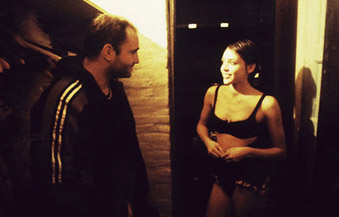|
|
Chapter TwoPusher IIBy Brett Ballard-BeachOctober 13, 2011
Along the same lines, Refn refuses to build to a manufactured climax of summation in Pusher III in order to tie it all together with some grand statement. As with Kieslowski’s Three Colors trilogy (which Pusher shares some parallels to), it is not necessary to see all the films in order to understand a larger picture, or watch them in chronological order. Several of the characters appear in multiple films with drug lord Milo, the protagonist in Pusher III, playing a significant supporting role in the first two. What Refn does with Pusher II is particularly bold in that he chooses not to focus more closely on the two most fascinating and enigmatic characters from Pusher, Milo and his chief enforcer Radovan (who in the fine tradition of chief enforcers is both fiercer than the boss, and not without a sense of humor or heart). The story’s arc concerns Tonny - the partner/sidekick/tagalong of Frank - who is just out of prison, with vague wishes to avoid repeat incarceration, but a complete inability to stay on the straight and narrow path. Through his alignment with the sketchy and unreliable Curt (the Cunt), Tonny winds up in a position of indebtedness similar to the clusterfuck Frank experienced, but with the added heartache that comes from being the n’er-do-well son of a local crime legend - The Duke - who never misses a chance to ridicule Tonny or heap love on his much younger son, sired by a local prostitute, while his former wife and Tonny’s mother has been long shuttled out of the picture. These family dynamics - that were absent from the first film but play a major part here and in Pusher III - most likely result from Refn’s foray into fatherhood and marriage in the intervening decade. There is a fascinating parallel between Tonny and Milo’s stories in the two films, The former struggles to prove himself worthy to a father who will never accept him while discovering that he became a dad himself while in jail, while the latter finds himself helpless at the hands of his grown daughter as he plans her 25th birthday. The criminal world can be savage, Refn suggests, but fatherhood, and the tenuous ties of parent and child relationships, is where the real carnage lies. It is also where the only hope for some kind of redemption can be located.
|

|
|
|

|
Friday, November 1, 2024
© 2024 Box Office Prophets, a division of One Of Us, Inc.


